Best Watches With Stopwatch [Key Factors To Consider]
Note: This page contains affiliate links.
As an Amazon Associate, I earn from qualifying purchases when you click on the link, but you are not charged extra.
Watches with stopwatch features, also known as chronograph watches, are essential timepieces for those who value precision and functionality. Whether you’re an athlete, a fitness enthusiast, or simply someone who appreciates the technical capabilities of a good watch, these versatile devices offer more than just timekeeping. With the ability to measure elapsed time, they can be used for timing races, workouts, or even day-to-day tasks. In this buyer’s guide, we’ll explore the key factors to consider when choosing the perfect stopwatch watch to suit your needs and lifestyle.
When selecting a watch with a stopwatch, you’ll need to think about several aspects, including design, durability, accuracy, and ease of use. With so many options available-ranging from digital sports models to sleek, luxury chronographs-the right choice will depend on your personal preferences and intended usage. From water resistance to battery life and additional features like lap memory or split time tracking, this guide will help you navigate through the options to find the best watch that combines style and functionality.
Best Watches With Stopwatch: Quick Comparison Table
| Features | Pros | Cons | |
|---|---|---|---|
Kids Unicorn Digital Watch Set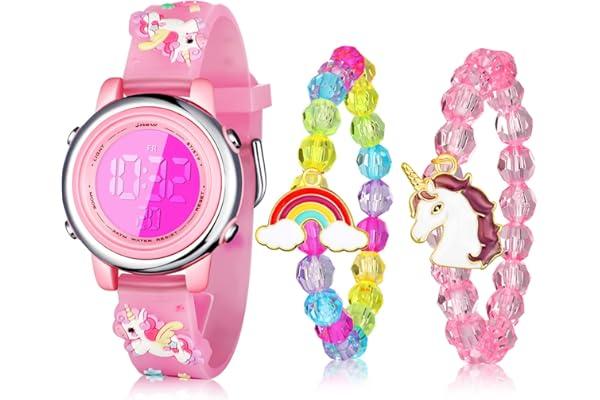 Check Price Check Price |
|
|
|
Paw Patrol Kids Smart Watch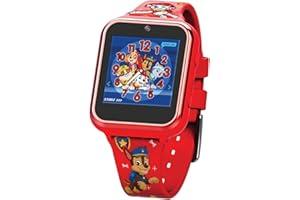 Check Price Check Price |
|
|
|
CakCity Men’s Military Digital Sports Watch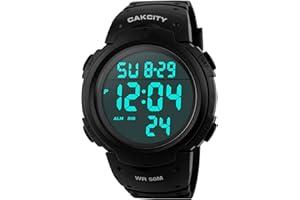 Check Price Check Price |
|
|
|
Men’s Waterproof Digital Sports Watch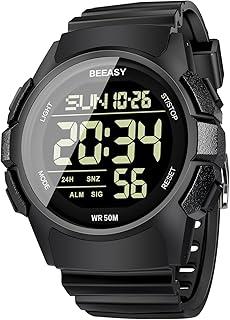 Check Price Check Price |
|
|
|
Ultra-Thin Men’s Digital Sports Watch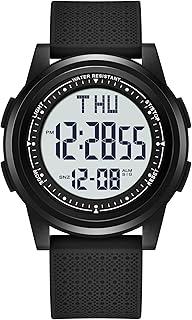 Check Price Check Price |
|
|
|
Men’s Waterproof Sport Digital Watch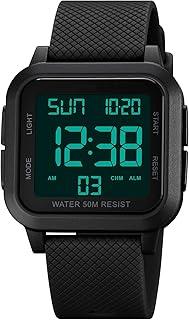 Check Price Check Price |
|
|
|
Tactical Digital Analog Military Watch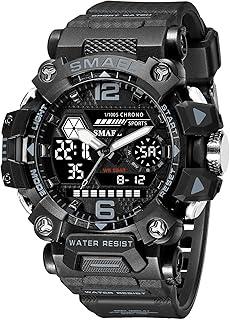 Check Price Check Price |
|
|
|
Gold Digital Sport Watch Check Price Check Price |
|
|
|
Alloy Shell Square Digital Watch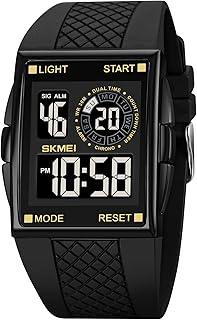 Check Price Check Price |
|
|
|
| Simple Waterproof Fitness Tracker Watch |
|
|
|
Recommendations For Best Watches With Stopwatch
Kids Unicorn Digital Watch Set
The Kids Unicorn Digital Watch Set combines fun with functionality, featuring a vibrant design that includes a matching unicorn bracelet. It’s waterproof and perfect for everyday wear, ensuring your child can enjoy it during various activities. With essential functions such as an alarm and stopwatch, this watch not only serves as a stylish accessory but also as a learning tool to help kids grasp the concept of time.
Features:
- Digital display
- Waterproof design
- Alarm and stopwatch functions
- Includes a matching unicorn bracelet
- Light-up feature
Pros:
- Fun and colorful design appeals to children
- Durable and waterproof for everyday use
- Includes accessories that enhance playfulness
- Educational features like time-telling and alarms
Cons:
- May be too bulky for very small wrists
- Battery life may require frequent replacements
- Limited functionality compared to adult watches
Paw Patrol Kids Smart Watch
The Paw Patrol Kids Smart Watch is designed to captivate young fans of the series, providing a range of interactive features such as games, a built-in camera, and a voice recorder. This smartwatch also includes a calculator and pedometer, promoting both fun and physical activity. Ideal for boys and girls, it is lightweight and user-friendly, making it a perfect accessory for adventure-filled days.
Features:
- Interactive games and activities
- Built-in camera
- Voice recorder
- Calculator and pedometer features
- USB charging cable included
Pros:
- Engaging features keep kids entertained
- Encourages physical activity with pedometer
- Camera adds a creative element
- Lightweight and easy to wear
Cons:
- Screen may be too small for some tasks
- Battery life could be limited with heavy use
- Limited durability for rough play
CakCity Men’s Military Digital Sports Watch
The CakCity Men’s Military Digital Sports Watch combines functionality and rugged design, featuring a large LED display that enhances visibility. Its waterproof build makes it perfect for outdoor adventures, while the luminous display ensures readability even in low light. With a stopwatch and alarm included, this watch caters to the needs of active individuals who appreciate both style and utility.
Features:
- Large LED display
- Waterproof construction
- Luminous features for low light
- Stopwatch and alarm functionalities
- Durable military design
Pros:
- Sturdy build suitable for outdoor activities
- Clear visibility in dark conditions
- Multiple functions for versatility
- Stylish military aesthetic
Cons:
- Bulky for some wearers
- Limited fashion versatility
- May require regular battery changes
Men’s Waterproof Digital Sports Watch
The Men’s Waterproof Digital Sports Watch is crafted for active lifestyles, featuring essential functions like a stopwatch, countdown timer, and dual time zone display. Its waterproof construction ensures reliability during water-related activities, while the comfortable rubber strap provides a secure fit. This watch is perfect for men and students who need a practical and stylish timepiece for daily use.
Features:
- Waterproof design
- Stopwatch and countdown timer
- Alarm function
- Dual time zone display
- Comfortable rubber strap
Pros:
- Versatile for various sports and activities
- Lightweight and comfortable to wear
- User-friendly interface
- Ideal for students and active individuals
Cons:
- Basic design may not appeal to everyone
- Limited advanced features
- Rubber strap might wear out over time
Ultra-Thin Men’s Digital Sports Watch
The Ultra-Thin Men’s Digital Sports Watch is a blend of style and functionality, featuring an ultra-thin profile and a big face for effortless readability. Equipped with a stopwatch, alarm, and calendar display, this watch serves multiple purposes while maintaining a fashionable appearance. Its waterproof capabilities make it a reliable choice for daily wear, suitable for both men and women.
Features:
- Ultra-thin design
- Big face for easy reading
- Stopwatch and alarm functions
- Calendar display
- Waterproof capabilities
Pros:
- Sleek and modern design
- Easy to read at a glance
- Suitable for both men and women
- Great for everyday use and special occasions
Cons:
- Thin design may feel fragile to some
- Limited durability under extreme conditions
- Battery life can vary with usage
Men’s Waterproof Sport Digital Watch
The Men’s Waterproof Sport Digital Watch is designed for active individuals, featuring an LED backlight for easy reading in all lighting conditions. With an alarm, countdown timer, and dual time display, it caters to various needs, making it suitable for both sports and daily activities. Its waterproof construction adds to its reliability, ensuring it withstands outdoor adventures.
Features:
- LED backlight for visibility
- Alarm and countdown timer
- Dual time display (12/24-hour format)
- Waterproof construction
- Suitable for men, women, and teenagers
Pros:
- Versatile for various sports and activities
- Stylish and functional design
- Clear visibility in all lighting conditions
- User-friendly interface
Cons:
- May feel bulky for some users
- Basic design may lack advanced features
- Battery life depends on usage frequency
Tactical Digital Analog Military Watch
The Tactical Digital Analog Military Watch is engineered for durability and style, featuring both digital and analog displays. Its large face ensures readability, while the waterproof and rugged construction makes it suitable for outdoor adventures. Equipped with LED alarm and stopwatch functions, this watch is perfect for anyone seeking a versatile and functional timepiece that can withstand tough conditions.
Features:
- Tactical digital and analog display
- Waterproof and durable construction
- Large face for easy reading
- LED alarm and stopwatch functions
- Multiple color options available
Pros:
- Rugged design for outdoor use
- Versatile style suitable for various occasions
- Easy to read with large display
- Multiple functions enhance usability
Cons:
- Can be heavy for some users
- Analog features may require additional maintenance
- Price may be higher than basic models
Gold Digital Sport Watch
The Gold Digital Sport Watch is a striking combination of elegance and functionality, featuring both digital and analog displays. Its waterproof design ensures reliability, while the three alarms and countdown timer cater to various needs. Perfect for both casual and formal settings, this watch’s military-inspired style makes it a standout accessory for any outfit.
Features:
- Digital and analog display
- Waterproof functionality
- Three alarms and countdown timer
- Dual time zone display
- Military style with multifunctional features
Pros:
- Stylish gold finish adds elegance
- Multiple functionalities for convenience
- Suitable for both casual and formal occasions
- Easy to read and use
Cons:
- Gold finish may wear off over time
- Can be bulky for some users
- Battery life can vary with usage
Alloy Shell Square Digital Watch
The Alloy Shell Square Digital Watch combines modern aesthetics with practical features. Its large square face and durable glass screen ensure high visibility and protection. With a waterproof design and essential functions like a stopwatch and alarm, this watch is perfect for casual wear. Its versatile style makes it suitable for both men and women, enhancing any outfit effortlessly.
Features:
- Glass screen for durability
- Large square face for visibility
- Waterproof design
- Stopwatch and alarm functions
- Casual and stylish appearance
Pros:
- Modern design appeals to diverse users
- Durable glass and alloy materials
- Easy to read at a glance
- Suitable for daily wear
Cons:
- Square shape may not suit everyone
- Limited advanced features
- Rubber strap may wear out over time
Simple Waterproof Fitness Tracker Watch
The Simple Waterproof Fitness Tracker Watch is perfect for fitness enthusiasts looking for a straightforward solution. With features such as a step counter, pedometer, and calorie tracking, this watch helps users monitor their activities without the need for a smartphone app. Its waterproof design allows for swimming, and the vibration alarm adds a layer of convenience, making it a versatile choice for individuals of all ages.
Features:
- Waterproof design for swimming
- Step counter and pedometer
- Vibration alarm and calorie tracking
- No app required for use
- Distance tracking and stopwatch features
Pros:
- User-friendly and straightforward design
- Ideal for various fitness activities
- No need for smartphone integration
- Durable for active lifestyles
Cons:
- Limited advanced tracking features
- Basic design may lack appeal for some
- Battery life can vary with usage
What To Consider When Choosing Watches With Stopwatch
Choosing a watch with a stopwatch function involves much more than merely selecting a timepiece that displays seconds. These watches serve a variety of purposes, ranging from athletic training to professional timing in various fields. When considering a watch with a stopwatch, several critical factors come into play. Here, we delve into these considerations in detail:
1. Purpose And Use Case
Understanding the primary purpose of the watch is crucial. Are you an athlete needing precise timing for your workouts, or do you need a stopwatch for professional use, such as in cooking or scientific experiments? For athletes, features like lap timers and multiple timers can enhance training efficiency. On the other hand, professionals may prioritize accuracy and functionality. Knowing how you will use the stopwatch function helps narrow down your choices significantly.
2. Accuracy And Precision
The reliability of a stopwatch is paramount, particularly in competitive settings. Most digital watches offer high precision, often measuring down to 1/100th or even 1/1000th of a second. Analog stopwatches, while classic, may not provide the same level of precision, especially if their mechanics are not finely tuned. Look for brands known for their accuracy in timekeeping, as this ensures that your stopwatch will serve you well in critical situations.
3. Ease Of Use
A stopwatch should be user-friendly. Consider how intuitive the watch’s controls are. For instance, large, clearly labeled buttons are essential, especially if you’re using the stopwatch while engaged in a sport where you might have limited visibility or the need to act quickly. Digital displays often offer better readability than analog dials in fast-paced scenarios. Additionally, look for features like backlighting, which can enhance usability in low-light environments.
4. Design And Aesthetics
Watches are not merely functional; they are also fashion statements. The design should reflect your style, whether you’re drawn to the sleek lines of a modern digital watch or the classic charm of an analog stopwatch. Consider the materials used—stainless steel, silicone, or resin—and how they will feel on your wrist over extended periods. The color, weight, and overall aesthetic should harmonize with your wardrobe and personal preferences, ensuring that you feel comfortable and confident wearing it.
5. Durability And Water Resistance
Watches, especially those designed for active lifestyles, must be durable. Look for features such as scratch-resistant glass, shock resistance, and robust construction. If you plan to wear the watch while swimming or in inclement weather, water resistance is crucial. Many sport watches are rated for varying depths (e.g., 30m, 100m, or even more), indicating their capability to withstand water exposure. Check the watch’s specifications to ensure it meets your lifestyle needs.
6. Battery Life And Maintenance
For digital watches, battery life can be a significant factor. Some stopwatches may require frequent battery changes, which can be inconvenient. Solar-powered options are available, providing a sustainable solution with minimal maintenance. Analog stopwatches may require winding or servicing over time, so consider how much upkeep you are willing to perform. Additionally, some digital models feature rechargeable batteries, allowing for extended use without the hassle of replacement.
7. Brand Reputation And Warranty
The brand of a watch often reflects its quality and reliability. Established brands typically offer better craftsmanship, and customer support, and have a proven track record in the industry. Look for customer reviews and ratings to gauge the experiences of others. A warranty can provide peace of mind, protecting your investment in case of defects or malfunctions. Reputable brands usually offer warranties that cover several years, indicating confidence in their product quality.
8. Additional Features
Many modern watches come equipped with a plethora of additional features that can enhance functionality. Beyond the basic stopwatch function, consider options such as multiple timers, lap counters, heart rate monitors, GPS capabilities, and smartphone connectivity. These features can provide added convenience and insights into your training or professional activities. However, ensure that these additional functionalities don’t complicate the watch’s usability; sometimes, simpler is better.
Choosing a watch with a stopwatch function requires careful consideration of multiple factors to ensure it aligns with your needs and lifestyle. From the watch’s purpose, accuracy, and ease of use to its design, durability, and additional features, each aspect plays a pivotal role in selecting the right timepiece. By taking the time to evaluate these considerations, you can find a watch that not only serves as an effective stopwatch but also complements your style and enhances your daily activities.
In the end, a well-chosen stopwatch watch can be an invaluable tool, whether for achieving fitness goals, managing time in professional settings, or simply enjoying the precision of a finely crafted timepiece. Embrace the journey of finding the perfect watch, and you’ll undoubtedly discover a reliable companion that stands the test of time.
Benefits Of Owning Watches With Stopwatch
Owning a watch equipped with a stopwatch feature offers a plethora of advantages that cater to various lifestyles and activities. Beyond merely being a stylish accessory, these timepieces serve practical functions that enhance our daily lives. Let’s explore the benefits of having a watch with a stopwatch, delving into its various applications, technological advancements, and the added value it brings to different users.
Precision Timing For Sports And Fitness
For athletes and fitness enthusiasts, the stopwatch is an indispensable tool. Whether you are a runner, swimmer, cyclist, or involved in any competitive sport, having accurate timing can significantly influence performance. A stopwatch allows athletes to:
-
Measure Performance: By tracking lap times, intervals, or the duration of a workout, athletes can measure their performance with precision. This data is crucial for setting personal bests and achieving fitness goals.
-
Enhance Training Regimens: Athletes can utilize the stopwatch to break their workouts into intervals, allowing for high-intensity training followed by rest periods. This method, often called interval training, is highly effective for improving cardiovascular fitness and overall endurance.
-
Monitor Progress: Regularly using a stopwatch helps athletes track improvements over time. The ability to compare past performances to current times offers valuable insights into training effectiveness and personal growth.
Versatility Beyond Sports
While the primary audience for watches with stopwatches might be athletes, the functionality extends far beyond the realm of sports. These watches can be beneficial in several other contexts:
-
Cooking and Baking: A stopwatch is a chef’s best friend, allowing home cooks and professionals alike to time cooking processes precisely. Whether boiling pasta, baking a cake, or ensuring that a roast is cooked to perfection, accurate timing can make all the difference in culinary success.
-
Scientific Experiments: In laboratories, precision timing is critical. Scientists often need to measure the duration of reactions or the time taken for certain processes. A stopwatch integrated into a wristwatch provides easy access to timing tools without the need for bulky equipment.
-
Time Management: In our fast-paced lives, managing time efficiently is crucial. A stopwatch can help individuals manage their time better in various activities, such as work tasks, meetings, or study sessions. By setting specific time limits, people can enhance productivity and stay focused.
-
Entertainment and Games: From board games to outdoor sports, many activities rely on timing. A stopwatch can enhance the competitive edge in games, allowing players to keep track of time limits and improve their strategies.
Technological Advancements
Modern watches equipped with stopwatches have evolved dramatically, incorporating sophisticated technology that enhances their functionality and user experience. Features often found in contemporary stopwatch watches include:
-
Digital Displays: Many watches now feature bright, easy-to-read digital displays, which allow for quick and precise readings of times and laps.
-
Multiple Chronograph Functions: Advanced stopwatch watches can track multiple events simultaneously, such as lap times and total elapsed time, providing a comprehensive overview of performance.
-
Water Resistance: Many sports watches with stopwatch features are designed to withstand various environments, including water resistance, making them suitable for swimming and other water-based activities.
-
Bluetooth Connectivity: Some modern watches can connect to smartphones via Bluetooth, allowing for synchronization of data and access to apps that provide further insights into performance and training metrics.
-
Customizable Features: Users can often customize settings, such as lap notifications and countdown timers, ensuring that the watch meets individual needs and preferences.
Style And Statement
Beyond functionality, a watch with a stopwatch feature serves as a fashionable accessory that can complement any outfit. The market offers a diverse range of designs, materials, and styles, allowing individuals to express their personality and taste. A stopwatch watch can be sleek and modern for those in corporate settings or rugged and durable for outdoor enthusiasts. This versatility means that you can wear your stopwatch watch for any occasion, seamlessly transitioning from workout sessions to social events.
In a world where precision and time management are increasingly essential, owning a watch with a stopwatch feature can be a game-changer. From enhancing athletic performance to improving everyday tasks, these timepieces are more than just accessories; they are tools that empower individuals to achieve their goals. The technological advancements incorporated into modern stopwatch watches offer users an unparalleled combination of functionality and style. Whether you are an athlete, a culinary enthusiast, a busy professional, or someone who values efficiency, a stopwatch watch provides a reliable and stylish solution for managing time effectively. Investing in one of these watches not only equips you with a practical tool but also adds a touch of elegance to your daily life, making it a worthy addition to any collection.
Features To Look For In The Best Watches With Stopwatch
When selecting a watch that incorporates a stopwatch feature, there are several crucial aspects to consider, ensuring you choose a timepiece that meets your needs, enhances your lifestyle, and reflects your personal style. Here’s a detailed exploration of the features to look for in the best watches with a stopwatch:
1. Accuracy And Precision
At the heart of every stopwatch is its ability to measure time accurately. The best watches feature high-quality movements—whether quartz or mechanical—that provide precise timing. Quartz movements are renowned for their reliability, typically with an accuracy of ±15 seconds per month, while high-end mechanical movements may offer remarkable precision through careful craftsmanship.
2. Ease Of Use
A user-friendly interface is essential for a stopwatch. Look for watches with clearly marked buttons that are easy to press, allowing you to start, stop, and reset the stopwatch with minimal effort. Additionally, intuitive displays that distinguish between standard time and stopwatch mode can enhance usability, particularly for those who may be less experienced with sophisticated timepieces.
3. Display Type
The display of a watch can significantly influence how easily you can read the time and stopwatch measurements. Digital displays often offer a straightforward, quick glance at elapsed time, while analog watches provide a classic aesthetic. Hybrid designs, featuring both analog and digital elements, can provide the best of both worlds. Additionally, consider watches with backlighting or luminous dials for readability in low-light conditions.
4. Lap Timer And Split Time Functionality
For those using their stopwatch for activities such as running or racing, lap timer and split time features are invaluable. These functionalities allow users to track multiple intervals without losing the total elapsed time. Watches with memory functions that can store previous lap times can also be beneficial, enabling athletes to monitor their progress over multiple sessions.
5. Durability And Water Resistance
A watch’s durability is crucial, especially for those using it in demanding environments. Materials like stainless steel, titanium, or reinforced resin can enhance durability. Furthermore, a water-resistant rating is vital for active users or those who engage in water sports. Look for watches with a minimum water resistance of 50 meters, which can withstand splashes and brief submersion.
6. Battery Life
For digital stopwatches, battery life is a significant consideration. Some models offer extended battery life, with lithium batteries lasting several years before needing replacement. Solar-powered watches are also a growing trend, allowing users to recharge their timepiece using natural or artificial light, ensuring the stopwatch is always ready when needed.
7. Comfort And Fit
A watch is only as good as its fit on the wrist. When evaluating a stopwatch watch, consider the band material and design. Options include leather, metal, and synthetic materials, each offering different comfort levels and aesthetics. Ensure that the watch has an adjustable strap for a secure fit, accommodating different wrist sizes.
8. Aesthetic Appeal
The visual aspect of a watch is paramount for many users. A stopwatch watch should resonate with your style, whether you prefer a sleek, modern look or a rugged, sporty design. Consider the color scheme, case shape, and overall design language, as these elements contribute significantly to the watch’s aesthetic appeal.
9. Additional Features
Many modern watches come with a plethora of additional features that enhance functionality. These may include GPS for distance tracking, heart rate monitors, or even connectivity to smartphones for tracking data. While not essential for every user, these features can significantly increase the watch’s versatility.
Choosing the best watch with a stopwatch requires a careful balance of features that suit your lifestyle and personal preferences. By considering accuracy, ease of use, display type, lap timer functionality, durability, battery life, comfort, aesthetics, and additional features, you can find a timepiece that not only meets your timing needs but also serves as a stylish accessory.
Ultimately, the right stopwatch watch can enhance your daily activities, whether you are an athlete aiming for personal bests or someone who enjoys the precision of timed events. A well-chosen timepiece reflects not only a commitment to quality and functionality but also an expression of individuality and style. Whether you’re hitting the track, timing a project, or simply enjoying the elegance of a finely crafted watch, making an informed choice will ensure your satisfaction for years to come.
How To Choose The Right Size
When it comes to watches, particularly those equipped with a stopwatch feature, selecting the right size is crucial—not just for aesthetic appeal but also for comfort and functionality. The size of a watch can affect not only how it looks on your wrist but also how it feels during everyday activities, whether you’re timing a sprint, cooking, or participating in a high-intensity sport. In this guide, we will explore the various factors influencing watch size selection, from case diameter to strap length, and how these elements can enhance your overall experience with a stopwatch watch.
Understanding Watch Sizes
Watches come in various sizes, typically measured in millimeters (mm) and referring to the case diameter. Generally, watch sizes can be categorized as small (below 36mm), medium (36mm to 42mm), large (43mm to 50mm), and extra-large (above 50mm). While the size of the watch case is often the focal point, it’s essential to consider other aspects like thickness, weight, and strap width.
Case Diameter
The case diameter is perhaps the most crucial measurement when choosing a watch. For men, a larger case—typically between 40mm and 50mm—can convey a more masculine aesthetic, whereas women often prefer smaller sizes, generally ranging from 26mm to 38mm. However, trends have shifted toward unisex styles, with many women opting for watches that fall within the 36mm to 42mm range.
When selecting a case diameter, consider your wrist size. A watch that appears too large can overwhelm a smaller wrist, while a tiny watch might get lost on a larger wrist. A good rule of thumb is to choose a case diameter that is approximately half the width of your wrist. For example, if your wrist measures 7 inches (about 178mm), look for a watch with a case diameter of around 35mm to 45mm.
Case Thickness
Case thickness is another vital measurement that can impact comfort and aesthetics. Thicker watches can appear more robust and sporty, making them an excellent choice for outdoor or athletic activities. Conversely, slimmer watches provide a more elegant and understated look, perfect for formal occasions. A thicker case can also accommodate more advanced stopwatch mechanisms, but ensure that it doesn’t feel bulky on your wrist.
Strap Length And Width
The strap length should complement the case size, providing a harmonious look while ensuring comfort. The standard strap lengths for men’s watches typically range from 7.5 to 9.5 inches (190mm to 240mm), while women’s straps usually measure between 6 to 8 inches (150mm to 200mm). If you have a larger or smaller wrist, consider getting an adjustable strap or one with extra holes for a perfect fit.
Strap width also plays a role in the overall appearance of the watch. A wider strap can balance out a larger case, creating a cohesive look, while a narrower strap can enhance a watch’s delicacy. However, when it comes to stopwatch watches—particularly those designed for athletic use—a wider strap can provide more support and stability during physical activities.
Style Considerations
Style is subjective, yet it plays a significant role in how you perceive a watch’s size. For example, a sporty chronograph stopwatch may appear more substantial due to its multiple dials and additional features, while a minimalist design can seem less imposing despite a larger case size. It’s essential to choose a style that resonates with your personal taste and aligns with your lifestyle.
Functionality Vs. Aesthetics
While aesthetics are crucial, functionality is paramount, especially for stopwatch watches. A watch that is too bulky or heavy can hinder your movement, making it uncomfortable during activities that require precision timing. Thus, ensure that the watch not only fits well but also feels good during use. Try on different models and pay attention to how they feel when you wear them, especially during activities that involve wrist movement.
Additionally, consider the ease of use of the stopwatch feature. Larger buttons may be easier to press, particularly during physical activities, while a more compact design may require more precision. Your watch should seamlessly blend style and functionality, allowing you to utilize the stopwatch feature effectively without sacrificing comfort.
Choosing the right size for a watch with a stopwatch feature is a multifaceted decision that goes beyond mere aesthetics. It involves understanding your wrist size, preferences, and how you intend to use the watch. By considering factors such as case diameter, thickness, strap length, and style, you can find a watch that fits your needs while enhancing your overall experience. Ultimately, the perfect stopwatch watch will not only serve as a practical tool for timing but will also reflect your personality and style, becoming an integral part of your daily life. Whether you are an athlete tracking your performance, a busy professional juggling tasks, or someone who enjoys the intricacies of timekeeping, selecting a watch that fits comfortably and looks great is essential. Embrace the journey of finding the ideal stopwatch watch, and enjoy the blend of style and function that accompanies your choice.
Durability And Performance
In the realm of horology, watches that feature a stopwatch function have long captivated enthusiasts and casual users alike. These timepieces not only serve as stylish accessories but also embody a rich blend of durability and performance that sets them apart from their traditional counterparts. When exploring watches equipped with stopwatch capabilities, it’s essential to delve into the intricate aspects of their construction, materials, and technological advancements that contribute to their functionality and reliability.
The Mechanics Behind Stopwatch Functionality
At the core of a stopwatch watch is its movement, which can either be mechanical or quartz. Mechanical movements, revered for their craftsmanship, use a complex system of gears, springs, and levers to measure time. This type of movement is often found in high-end, luxury watches and appeals to aficionados who appreciate the artistry behind each tick. On the other hand, quartz movements, powered by battery and regulated by a quartz crystal, offer superior accuracy and lower maintenance requirements. The choice between these two types of movements significantly affects not only the performance of the stopwatch but also the overall durability of the watch.
Durability Through Materials
The durability of a stopwatch watch is significantly influenced by the materials used in its construction. High-quality stainless steel is a common choice for the watch case, offering excellent resistance to corrosion and wear. Additionally, many watches employ sapphire crystal for the watch face, providing exceptional scratch resistance and clarity. This makes them suitable for everyday wear, even in demanding environments.
Furthermore, some brands have turned to innovative materials such as titanium and ceramic, which enhance durability while reducing weight. Titanium, known for its strength and lightness, is a favorite among outdoor enthusiasts. Ceramic, with its ability to resist scratches and fading, is ideal for those seeking a watch that retains its aesthetic appeal over time.
Performance In Extreme Conditions
Watches equipped with stopwatch functions are designed to perform under various conditions, from casual sporting activities to professional competitions. Many of these watches boast features such as water resistance, shock resistance, and enhanced readability, ensuring that they remain functional and accurate regardless of the environment. For instance, dive watches often come with a stopwatch function and are rigorously tested to withstand significant underwater pressures, while sports watches are engineered to endure the rigors of high-impact activities.
Additionally, the performance of a stopwatch watch is often enhanced by technological innovations. Some models incorporate advanced digital displays and smart features that provide real-time data, making them invaluable tools for athletes and fitness enthusiasts. These smartwatches can track multiple laps, store historical data, and even sync with mobile applications, thereby revolutionizing the way users interact with timekeeping.
User Experience
The user experience of a stopwatch watch is paramount in its design. The usability of the stopwatch function is a critical factor that determines how effectively it can be employed. Many watches feature oversized buttons that are easy to access, even during vigorous activities. The tactile feedback provided by these buttons ensures that users can start, stop, and reset the stopwatch without distraction or confusion.
Moreover, the readability of the watch face plays a crucial role in performance. A well-designed dial with contrasting colors, clear markings, and luminous hands or digits allows users to quickly glance at the time without straining their eyes. This aspect is particularly important for athletes who need to track their performance at a glance.
Watches with stopwatch capabilities represent a harmonious blend of durability, performance, and user-centric design. Whether crafted with intricate mechanical movements or powered by precise quartz technology, these timepieces are built to endure the demands of various activities while delivering accurate timekeeping. The careful selection of materials ensures that they can withstand the rigors of daily wear, while advanced features enhance their functionality and user experience.
As technology continues to evolve, the future of stopwatch watches looks promising, with innovations that will undoubtedly enhance their capabilities further. For both the avid collector and the casual wearer, a stopwatch watch serves as more than just a timekeeping device; it embodies the pursuit of precision and durability, making it an essential accessory for anyone who values performance alongside style.
How To Care For Your Watches With Stopwatch
Owning a watch equipped with a stopwatch is not just about having a functional timepiece; it’s about possessing a piece of craftsmanship that blends precision engineering with style. To ensure that your stopwatch watch remains in optimal condition and continues to serve you reliably, it’s essential to understand the proper care and maintenance practices.
1. Regular Cleaning
Keeping your watch clean is paramount to its longevity and performance. Dust, sweat, and grime can accumulate on the watch’s surface, particularly in the crevices around buttons and the bezel. Here’s how to clean your stopwatch watch effectively:
- Materials Needed: A soft microfiber cloth, a soft-bristled toothbrush, and mild soap (if necessary).
- Step-by-Step Guide:
- Wipe Down the Surface: Begin by gently wiping the watch case and strap with a dry microfiber cloth to remove any surface dust and debris.
- Brush Away Dirt: For stubborn dirt, use a soft-bristled toothbrush lightly dampened with water. Gently brush around the buttons and in any grooves to dislodge any particles without scratching the surface.
- Soapy Solution: If the watch is particularly dirty, create a solution of mild soap and water. Dampen the cloth with this mixture (never soak the watch) and wipe the surfaces. Avoid getting moisture into the watch’s crown or buttons.
- Drying: Use a dry part of the microfiber cloth to wipe the watch dry, ensuring no moisture remains, especially around the buttons.
2. Avoiding Extreme Conditions
Watches with stopwatch functions can be sensitive to extreme temperatures, humidity, and magnetic fields. Here’s how to protect your watch from these elements:
- Temperature Extremes: Avoid exposing your watch to extreme heat or cold, as these can affect the movement’s accuracy. A temperature range between 32°F (0°C) and 140°F (60°C) is generally safe.
- Humidity: Water resistance varies by model. While some watches can withstand splashes or brief immersion, others may not. Always check the water resistance rating and ensure that the crown is fully pressed or screwed down before exposure to water.
- Magnetic Fields: Magnetic fields can disrupt the delicate mechanisms within your watch. Keep your stopwatch away from strong magnets, such as those found in speakers, refrigerators, or MRI machines.
3. Battery Maintenance
For quartz watches equipped with stopwatch functions, the battery plays a critical role in ensuring the timepiece runs smoothly. Here are some battery care tips:
- Regular Checks: If your watch begins to lose time or the stopwatch function becomes erratic, it may be time to replace the battery. Most batteries last between 1 to 5 years, depending on the model and usage.
- Professional Replacement: For optimal performance, have a professional jeweler or watch technician replace the battery. They can also check for any potential water damage and reseal the watch if necessary.
4. Mechanical Maintenance
If your stopwatch watch is mechanical, it requires a different kind of attention:
- Winding: Regularly wind your watch to keep the movement running. If your watch is an automatic model, wearing it daily can keep it wound, but if it sits idle for too long, it may require manual winding.
- Servicing: Mechanical watches should be serviced every 3 to 5 years by a professional. This involves cleaning, oiling, and checking the movement to ensure it operates correctly.
5. Strap Care
The care of your watch strap is just as crucial as the watch itself, as a well-maintained strap enhances the watch’s overall aesthetics and comfort:
- Leather Straps: Clean with a dry cloth and occasionally use a leather conditioner to prevent cracking and drying. Avoid exposing leather straps to water or extreme humidity.
- Metal Straps: Use a damp cloth for cleaning and consider a gentle jewelry cleaner to remove tarnish or grime. Avoid using excessive force, as this can scratch the metal.
- Rubber or Silicone Straps: Wipe down with a damp cloth regularly, as these materials can attract dust and sweat, leading to odor buildup over time.
Caring for your watch with a stopwatch function is essential for maintaining its precision, functionality, and aesthetic appeal. By following these best practices—regular cleaning, avoiding extreme conditions, monitoring the battery, performing necessary mechanical maintenance, and taking good care of the strap—you can ensure that your timepiece remains a reliable companion for years to come. Just as you would nurture any treasured item, treating your watch with respect and diligence will keep it ticking beautifully, allowing you to enjoy both its timekeeping and stopwatch features to their fullest potential. Investing time in proper care not only enhances the watch’s longevity but also preserves its value, making it a cherished part of your collection that can be passed down through generations.
This comprehensive guide ensures you have the knowledge needed to keep your stopwatch watch in excellent condition. If you have any specific questions or need further assistance, feel free to ask!
Comparing Watches With Stopwatches And Alternatives
Understanding Watches And Stopwatches
At first glance, watches and stopwatches may seem like mere timekeeping devices, but they serve distinct purposes and embody unique functionalities that cater to different needs. A watch is traditionally designed to provide the time of day, often featuring a multitude of functions beyond just time display. These functions can include date, day of the week, and even more complex features like altimeters, heart rate monitors, and GPS tracking, especially in modern smartwatches.
In contrast, a stopwatch is engineered primarily for timing events, providing the user with precise control over start, stop, and reset functions. Stopwatches are invaluable in competitive environments, such as athletics, scientific experiments, and culinary arts, where timing is crucial to performance and accuracy. They measure elapsed time in various formats, often displaying it in minutes, seconds, and tenths of seconds. This level of precision sets them apart from standard watches, which might round off time measurements.
Advantages Of Stopwatches
One of the most significant advantages of a stopwatch is its simplicity and focus on timing. They usually offer features like:
-
Precision Timing: Stopwatches typically have a much higher precision compared to watches. Most can measure time to a hundredth of a second or even finer, making them essential for activities where every millisecond counts.
-
Multiple Timers: Many modern stopwatches allow the user to track multiple events simultaneously, a feature particularly useful in sports competitions where multiple athletes are timed at once.
-
Lap Time Functionality: A common feature in many stopwatches is the ability to record lap times, allowing athletes and coaches to analyze performance across multiple segments of a race.
-
Durability: Many stopwatches are designed to be robust and often feature waterproof and shockproof casings, making them ideal for outdoor activities or rigorous environments.
Alternatives To Traditional Watches And Stopwatches
While watches and stopwatches serve their distinct purposes, there are numerous alternatives that blend these functionalities or offer new features entirely.
-
Smartwatches: These multifunctional devices combine the timekeeping capabilities of traditional watches with the advanced timing features of stopwatches. Smartwatches come equipped with fitness tracking capabilities, GPS navigation, heart rate monitors, and more. Users can download specific apps for timing activities, track workouts, and receive notifications, making them versatile companions for everyday use.
-
Fitness Trackers: Primarily designed for monitoring physical activity, fitness trackers often include stopwatch functions alongside heart rate monitoring and step counting. They are more compact than smartwatches and can be a preferable option for individuals focused solely on fitness rather than on receiving notifications or other smart features.
-
Mobile Apps: The proliferation of smartphones has led to a variety of stopwatch applications that mimic the functionalities of traditional stopwatches. These apps can be customized to suit different activities, provide visual lap time displays, and even generate reports on timing data. With their accessibility, they have become popular among athletes and professionals alike.
-
Hybrid Watches: Combining traditional analog design with smart features, hybrid watches maintain a classic aesthetic while incorporating functionalities such as step tracking, sleep monitoring, and basic notifications. While they may not offer the same level of timing precision as dedicated stopwatches, they cater to users looking for a blend of style and utility.
-
Dedicated Timing Devices: In specialized fields, such as cooking or scientific research, dedicated timing devices are available that offer highly specialized features. For example, cooking timers with preset intervals can simplify food preparation, while lab timers might include features for data logging and alarming for various experimental protocols.
The choice between watches, stopwatches, and their alternatives ultimately hinges on individual needs and preferences. For those whose primary concern is tracking time with precision, stopwatches remain unrivaled due to their focus and accuracy. However, the versatility and multifunctionality of modern alternatives, such as smartwatches and fitness trackers, present compelling options for the contemporary user seeking more than just timekeeping. While traditional watches continue to hold their charm and elegance, the evolving landscape of technology offers a plethora of choices tailored to diverse lifestyles. Whether one prioritizes style, precision, or functionality, there is a timekeeping solution to suit every taste and requirement. As we navigate our increasingly fast-paced lives, the right choice can enhance our ability to manage time effectively, leading to improved productivity, performance, and even enjoyment of everyday activities. The key lies in understanding the specific features that align with one's activities and preferences, ultimately ensuring that the chosen device is not just a tool for measuring time, but an indispensable companion in our daily journeys.
Style And Design Trends For Watches With Stopwatch
Watches that feature stopwatches, often referred to as chronographs, have transcended their initial utilitarian purpose to become emblematic of sophistication, precision, and style. The integration of stopwatch functionality into timepieces combines engineering with artistry, leading to an evolution of styles and design trends that resonate with a diverse range of consumers. As we explore the current trends in this niche, we will examine various factors, including aesthetic choices, materials, technological advancements, and the influence of lifestyle and fashion.
Aesthetic Choices
1. Minimalist Designs
Minimalism has taken the watch industry by storm, with many contemporary designs favoring clean lines, uncluttered dials, and understated elegance. Minimalist chronographs often feature a pared-down layout that emphasizes the stopwatch function without overwhelming the wearer with excessive details. These watches might include subtle markers for the chronograph sub-dials, ensuring that the focus remains on functionality while maintaining a refined aesthetic. Brands like Nomos Glashütte exemplify this trend, producing timepieces that marry utility with a sophisticated, no-frills design.
2. Vintage And Retro Inspirations
A return to classic styles has been a notable trend in recent years, with watchmakers drawing inspiration from the rich history of horology. Vintage-inspired chronographs often feature retro color palettes, aged leather straps, and intricate detailing reminiscent of mid-20th-century timepieces. This trend evokes nostalgia while catering to a growing appreciation for artisanal craftsmanship. Brands like Longines and TAG Heuer have successfully revived vintage models, infusing them with modern technology while maintaining the charm of their predecessors.
3. Bold And Sporty Looks
For the more adventurous consumer, bold and sporty designs have gained popularity, reflecting an active lifestyle and a desire for durability. These watches often showcase vibrant colors, large case sizes, and rugged materials, appealing to those who value both performance and style. The incorporation of innovative features such as tachymetric scales and rotating bezels enhances their functionality, making them ideal for sports enthusiasts. Brands like Seiko and Casio lead the charge in this segment, offering watches that seamlessly blend functionality with a dynamic aesthetic.
Material Innovations
1. Advanced Alloys And Coatings
The materials used in the construction of chronograph watches have evolved significantly, with manufacturers experimenting with advanced alloys and coatings to enhance durability and aesthetics. Stainless steel remains a popular choice, but brands are increasingly utilizing titanium for its lightweight and corrosion-resistant properties. Furthermore, ceramic watches have emerged as a favored option due to their scratch-resistant nature and sleek appearance. For instance, the IWC Portugieser Chronograph showcases a stunning ceramic case that combines elegance with resilience.
2. Eco-Friendly Materials
Sustainability has become a driving force in the design of modern timepieces, leading to the adoption of eco-friendly materials. Brands are exploring alternatives such as recycled metals, sustainable leathers, and innovative biopolymers. This trend reflects a broader cultural shift toward environmental consciousness and resonates particularly with younger consumers. Brands like Nordgreen emphasize ethical practices and eco-friendly materials, creating timepieces that align with the values of their clientele.
Technological Advancements
1. Smart Chronographs
The integration of smart technology into traditional chronograph watches marks a significant trend, appealing to tech-savvy consumers who seek connectivity without sacrificing style. Smart chronographs combine classic aesthetics with modern functionality, offering features such as fitness tracking, notifications, and customizable watch faces. This trend represents a convergence of traditional horology and cutting-edge technology, exemplified by models from brands like Garmin and Fossil that cater to both watch enthusiasts and tech users.
2. Enhanced Movement Accuracy
Advancements in watch movement technology have led to increased accuracy and reliability in chronographs. Brands are now employing sophisticated mechanisms, such as quartz movements and high-beat automatic calibers, to enhance precision. The development of in-house movements has also become a hallmark of luxury brands, showcasing their engineering prowess. For instance, the Breitling Navitimer is renowned for its accurate chronograph functions, appealing to aviation enthusiasts and precision seekers alike.
Influences From Lifestyle And Fashion
1. Influencer Collaborations
The rise of social media and influencer culture has significantly impacted the watch industry, with brands partnering with prominent figures to promote their chronograph models. These collaborations often emphasize lifestyle and fashion, showcasing how a timepiece can complement an outfit or enhance personal style. Limited-edition releases and exclusive designs aimed at specific influencers generate excitement and demand, making chronographs not just functional accessories but also fashion statements.
2. Gender-Neutral Designs
The concept of gender-neutrality has permeated the watch industry, leading to designs that appeal to a broader audience. Brands are increasingly offering chronographs that transcend traditional gender norms, featuring versatile styles that can be worn by anyone. This trend reflects a cultural shift towards inclusivity and individuality, with consumers seeking timepieces that resonate with their personal aesthetics rather than conforming to societal expectations.
Conclusion
The world of chronograph watches is a dynamic landscape where style and function intertwine in remarkable ways. From minimalist elegance to bold sportiness, the diverse range of aesthetic choices caters to varied tastes and lifestyles. Innovations in materials and technology have propelled the industry forward, introducing eco-friendly practices and smart functionalities that appeal to contemporary consumers. As lifestyle influences continue to shape watch design, the emergence of gender-neutral options and collaborations with influencers signifies a cultural shift toward inclusivity and personal expression.
In a market driven by trends and consumer preferences, the essence of chronographs remains unchanged: they symbolize a harmonious blend of art, engineering, and personal style. Whether embraced for their utility in timing athletic events or cherished as stylish accessories, these timepieces represent a timeless commitment to precision and craftsmanship, ensuring that they will continue to captivate watch enthusiasts and fashion aficionados alike for years to come.
FAQs
What Is A Stopwatch Function In Watches?
A stopwatch function in watches is a timing feature that allows users to measure elapsed time accurately. It typically operates independently from the watch’s primary timekeeping function and can measure time in various increments, often to the nearest second or millisecond.
How Do I Operate The Stopwatch Feature On My Watch?
Operating the stopwatch feature varies by watch model, but generally, it involves pressing a designated button to start and stop the timer. Some watches may have additional buttons for resetting the stopwatch or lap timing, allowing for more detailed tracking of intervals.
Can I Use The Stopwatch Function While The Watch Is In Regular Timekeeping Mode?
Yes, most watches with a stopwatch function allow you to use it while still displaying the current time. This means you can time events without interrupting your regular timekeeping.
What Types Of Activities Are Best Suited For Using A Stopwatch On A Watch?
Stopwatches are ideal for various activities, including sports events, cooking, workouts, and any situation where timing is crucial. They are especially beneficial for tracking lap times, intervals, or timed challenges.
Are All Watches With A Stopwatch Function Waterproof?
Not all watches with a stopwatch function are waterproof. The water resistance of a watch depends on its design and materials. Always check the manufacturer’s specifications to understand the watch’s water resistance capabilities before exposing it to water.
What Is The Difference Between An Analog And Digital Stopwatch In Watches?
Analog stopwatches typically use a mechanical movement with a dial and hands to display time, while digital stopwatches feature an electronic display that shows time in numerical format. Digital stopwatches often offer more precise timing and additional features like memory storage.
Can I Find Smartwatches That Include A Stopwatch Feature?
Yes, many smartwatches come equipped with a stopwatch feature, often integrated into their fitness tracking and health monitoring capabilities. Smartwatches may also offer advanced timing functions, such as lap tracking and syncing with fitness apps.
What Should I Consider When Purchasing A Watch With A Stopwatch?
When purchasing a watch with a stopwatch, consider factors such as ease of use, display type (analog or digital), additional features (like lap timing or memory), water resistance, and your specific needs, such as sports tracking or everyday use.
How Accurate Are Stopwatch Functions In Watches?
Stopwatch functions in quality watches can be very accurate, often measuring time to the nearest second or millisecond. However, accuracy can vary by brand and model, so it’s important to choose a reputable watch known for precision.
Are There Watches Specifically Designed For Athletes That Feature Stopwatches?
Yes, many sports watches are specifically designed for athletes and include advanced stopwatch features. These may have added functionalities such as heart rate monitoring, GPS tracking, and specific sport modes, making them ideal for competitive training.
